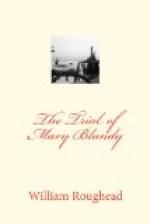of
A Letter from a Clergyman, to Miss Mary Blandy,
&c., with a note by the publisher intimating that,
for the satisfaction of the public, the original MS.
was left with him. The fair authoress having thus
fired the first shot, a fusilade of pamphlets began—the
spent bullets are collected in the Bibliography—which,
for volume and verbosity, is entitled to honourable
mention in the annals of tractarian strife.
An
Answer to Miss Blandy’s Narrative quickly
followed upon the other side, in which, it is claimed,
“all the Arguments she has advanc’d in
Justification of her Innocence are fully refuted, and
her Guilt clearly and undeniably prov’d.”
This was promptly met by
The Case of Miss Blandy
considered, as a Daughter, as a Gentlewoman, and as
a Christian, with particular reference to her
own
Narrative, the author of which is better
versed in classical analogies than in the facts of
the case. Mary herself mentions a pamphlet, which
she cites as
The Life of Miss Mary Blandy,
and attributes to “a French usher.”
This may have been one of the 1751 tracts containing
accounts “of that most horrid Parricide,”
the title of which she deemed too indelicate for exact
citation, or, perhaps, an earlier edition of
A Genuine
and Impartial Account of the Life of Miss Mary Blandy,
&c., the copy of which in the Editor’s possession,
including an account of the execution, was published
on 9th April, three days after the completion of that
ceremony.
The last literary effort of Mary Blandy was an expansion
of her Narrative, re-written in more detail
and at much greater length, the revised version appearing
on 18th April under the title of Miss Mary Blandy’s
Own Account of the Affair between her and Mr. Cranstoun,
“from the commencement of their Acquaintance
in the year 1746 to the Death of her Father in August,
1751, with all the Circumstances leading to that unhappy
Event.” This ingenious, rather than ingenuous,
compilation was, it is said, prepared with the assistance
of Parson Swinton, who had some previous experience
of pamphleteering on his own account in 1739.
Mr. Horace Bleackley has happily described it as “The
most famous apologia in criminal literature,”
and as such it is reprinted in the present volume.
Even this tour de force failed to convince
a sceptical world, and on 15th April was published
A Candid Appeal to the Publick concerning her
case, by “a Gentleman of Oxford,” wherein
“All the ridiculous and false Assertions”
contained in Miss Blandy’s Own Account
“are exploded, and the Whole of that Mysterious
Affair set in a True Light.” But by this
time the fair disputant was beyond the reach of controversy,
and the Oxford gentleman had it all his own way; though
the pamphleteers kept the discussion alive a year longer
than its subject.




